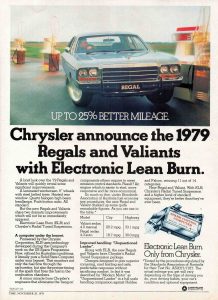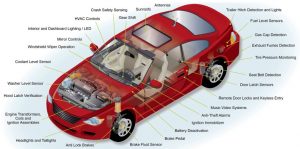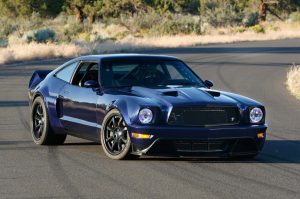Buying a new car is, per Dickens, a tale about the best of times and the worst of times.
As it was, once upon another time.
Back in the ‘70s and ‘80s, it was bad times indeed. New cars were Bergeroned – badly crippled – by grafted-on pollution control technology. Air-intakes deliberately choked; the exhaust corked; the fuel mixture fouled by regurgitated exhaust gasses and leaned out so far to the left of stoichiometric as to cause the strangulated, hot-running engine to buck and diesel even though it was trying to burn gasoline.
If they ran at all, it was by default – and usually not for long.
Gigantic V8s made less power than today’s small fours – and used three times as much fuel while delivering half the acceleration.
It was all done by government. Well, to placate the government. Which is to say, placate those other people who got their hands on political power – and used it to stifle the car. Or tried very hard to stifle it.
They claimed, of course, that it was for the sake of bequeathing clean air and good gas mileage to the helpless masses, allegedly powerless to insist on either thing themselves – not by force but by buying them – or by refusing to buy cars that didn’t deliver them.
The government’s claim was that the car industry was Soviet and monolithic; unresponsive to the market. That it made one-size-fist all and take it – or leave it.
Ironically, it now does that – because of the government.
But we are getting ahead. It wasn’t Soviet back then. It was merely that most people who bought cars weren’t much interested in – or willing to pay through the nose for – high gas mileage or low emissions. 
So the government forced them to.
But the true purpose was something altogether different. That underlying purpose was – and is – to strangle cars out of existence. These people despise the car because it is a four-wheeled rebuke to their managerial lust to control everything. If you do not control mobility, you don’t control much.
Ergo . . .
It got very bad for a while but then it got better – as the engineers got around the excuses and got back to delivering what the buyers wanted – and didn’t.
Which is why it is getting bad again – for the same reasons, both advertised and actual – just differently.
The Bergeroning has become less easy to see as well as to end-run. New car engines – and transmissions – are now designed primarily with compliance and its un-admitted-to corollary – control – front and center, from the drawing board forward, rather than as an after-the-fact afterthought.
It all works great – until it doesn’t
The interwoven complexity of a modern twin-scroll turbocharged, direct-injected engine with a 48 volt mild hybrid system, variable cam/valve timing, cylinder deactivation and multiple catalytic converters is such that the least glitch can glitch the entire system. The glitch may be an intermittent fault and randomly recurrent. The “technician” (as opposed to the mechanic, a species of Aurochs now extinct) is baffled because the other computer – the one he plugs the car into – doesn’t tell him what is wrong and so he has no clue what to do.
In the worst of times Mark I – the ‘70s and ‘80s – you could de-Bergeron the government-crippled engine. It was not only possible, it was sensible to remove the Face Diapering air cleaner and replace it with one that let the engine inhale normally; to adjust the carburetor such that a proper air-fuel mix was dialed in. Unplug the exhaust and clear out the rat’s nest of vacuum hoses that created vacuum leaks, inevitably.
Un-tard the retarded ignition timing.
In a few hours, you had a car that ran better and stronger and which required less maintenance, most of which you could easily perform yourself. Those pathetic V8s that made less power than today’s turbo GDI’d four cylinder engines? They could be made to produce twice as much horsepower with a few simple modifications well within the capabilities of anyone capable of carefully reading a shop manual and following the instructions.
They were fixable, in the manner of a strong man artificially disabled by the application of braces to his legs and arms (and a Face Diaper stifling his lungs). Take the hobbles off and the man is strong again because he is fundamentally strong. Parts could be swapped, mixed and matched – and the car would run, usually better.
The worst of times Mark II is fundamentally different.
Engines are now very strong indeed, almost regardless of their size. And they don’t buck or diesel (unless they are diesels, and even then you hardly notice because they are so very quiet). But they are also very weak as a function of their Byzantine complexity, in the manner of a chain with numerous weak links you can’t see.
Everything works dandy until it doesn’t. And then it really doesn’t.
You cannot de-Bergeron the new stuff, either. It is enmeshed and integrated and embedded beyond such remediation.
The artifices don’t hobble. But they do limit – in every way except what they cost. Which is itself another kind of limit.
There is very little you can do and even what the technician can do is often limited. Under the hood (and under the dash, where the computer is – and in the body – where more computers are) is a warren of wiring and sensors, the concatenation beyond the probable ken of any single human intelligence.
There is also the unforgiving hard deck limit of what your wallet can do.
Back in the worst of times – Mark I – most people could afford a tune-up or even a top-end rebuild because it was relatively inexpensive in itself and relative to the value of the car itself. It was reasonable to spend $500 on a car worth $3,000. It is not reasonable to spend $3,000 on a car worth $5,000.
Also, most people simply haven’t got the money. That is to say, the cash. Finance the fix – on a credit card at 14 percent interest – or finance the new car loan at 3 or 4? The latter seems more “affordable” because the payments are lower. They just never end. But never mind.
Check out that new touchscreen!
. . .
Got a question about cars, Libertarian politics – or anything else? Click on the “ask Eric” link and send ’em in!
If you like what you’ve found here please consider supporting EPautos.
We depend on you to keep the wheels turning!
Our donate button is here.
If you prefer not to use PayPal, our mailing address is:
EPautos
721 Hummingbird Lane SE
Copper Hill, VA 24079
PS: Get an EPautos magnet or sticker or coaster in return for a $20 or more one-time donation or a $10 or more monthly recurring donation. (Please be sure to tell us you want a magnet or sticker or coaster – and also, provide an address, so we know where to mail the thing!)
If you’d like an ear tag – custom made! – just ask and it will be delivered.
My latest eBook is also available for your favorite price – free! Click here. If that fails, email me at [email protected] and I will send you a copy directly!












Modern cars are complicated to modify, but it’s certainly doable – throw in bigger turbo, change out exhaust or intake, even convert it to running on E85, which is really good for massive power gains. I’m a tech nerd who’s figured out how to do that, but in order to do this, you need wrenching skills, which most people can learn, it’s not rocket science, but you also need to understand how to work with an oscilliscope, and change air/fuel maps, etc.
Now, assuming you can do that, you still can’t legally drive that car due to the laws around modifying cars. Whenever you touch intake or exhaust, meaning, basically anything, you are now afoul of laws for messing with emissions systems. Here in CA, it makes your car illegal to drive, and they check every 2 years for these modifications. Doesn’t matter if it’s a rusty death trap, but as long as emissions equipment works, it’s good to drive. If you modify the car, and even if it still runs perfectly clean, doesn’t matter, you’ve made modifications, so it’s illegal.
For several years in the mid-90s I was on the county planning and zoning board. I attended a meeting of GovCo planners that was put on by a group of New Urbanist/Neo-Traditional city designers. They were all about “walkable communities”.
In the middle of the presentation a water-color slide (this was pre-Powerpoint) came up of the ideal “center city”. the presenter made the comment, “you’ll notice there are no cars in our center city…this is AFTER the Revolution.” The room erupted in laughter and applause. The fellow I went with was also a libertarian, we looked at each other in horror.
Another quarter century has passed in The Long March through the institutions. The Marxists are winning…for the moment. The good news is that it always implodes under the weight of its own contradictions. Too bad so many will suffer along the way.
A thing never considered by the “environmentalists” as they sit in their ivory tower and dictate how we are to build products. The cost of replacing them, and the consumption of resources doing so. How much fuel do you suppose it takes to BUILD a car? Back when there was lot’s of steel in one, it took about as much to build one as it would burn in its lifetime. Not so much today, but still quite a bit nonetheless.
There are a couple of mechanical truisms that are largely ignored.
The more complex a machine, the more likely it is to fail.
Any time you increase power, you increase breakage. If the increase in power is in an engine with lesser bearing surface. as in a turbocharged four cylinder, it gets worse yet.
I find it quite remarkable that the effect of much of environmental engineering is an increase in throw away products.
The answer is that the envirnomentalists don’t care. Not a bit.
My 1980 K/10 that I bought brand new ran just fine, and got pretty decent gas mileage too.
Cars being un-modable and needlessly complicated is a feature not a bug. First it gets you in the mood to buy the dealer’s routine maintenance package. Second it discourages shade tree mechanics from trying to fix anything yourself, better to take it to the dealer. And third, it opens up a market for mechanical repair auto insurance and extended warranties.
In the article, “There is very little you can do and even what the technician can do is often limited.” I enjoy and appreciate cars. Unfortunately, in High School in the early 70’s I did not take advantage of Auto Shop. When I watch Youtube like LegitStreetCars, https://www.youtube.com/channel/UCT-2OPZT6P8j4nEKW3DXpOA, he takes his cars in for a programmed tune. Are those programmed tunes limited? Thanks
Hi Gary,
When car engines didn’t have computer controls, they were physically adjustable. For example, you used a screwdriver to turn the idle mix control screws in or out to richen or lean the idle mixture; you could unbolt a part and install a new part, including parts that weren’t original to the engine or even made by the same manufacturer. So long as they physically fit, it would work.
Computer controlled engines are fundamentally electronic and there is less adjustability. A “programmed” tune – or adjustment – means hooking the car’s computer to a diagnostic computer to check codes; with some new cars, a new part – even a “correct” part – the part will only work if the part is coded to the system.
An ECU can sometimes be “reflashed” or (older computer controls) “chipped” but – again – it’s more an electronic process than a hands-on mechanical one. And it’s a much more complicated and expensive one for that reason.
Çhanging jets/amping up ignition timing involved basic tools and cost almost no money. While all the engine’s systems (air/fuel/spark) needed to work together to work well, they were once more independent of one another whereas today everything is connected – literally – by electronics.
Consider a Ford F-350 with the 6.7L Powerstroke diesel in it. It is insane that it can produce 475 hp and 1050 lb-ft of torque even with all the horrid emissions complexity imposed upon it, and it can still get around 20-22mpg on the highway. Interestingly, it is possible to remove the DEF/DPF and EGR systems (called a “delete”) on these engines, though it is considered highly illegal due to Uncle Sam. Yet by all accounts, such a modified system, which requires a bit of computer reprogramming but not “tuning” in the traditional sense, will garner you about 30% more power and 30% more fuel economy while also improving longevity of the system, a system which is already commonly good for 300,000+ miles easily with proper maintenance. I have no clue how much it would cost to have such an engine modified. I’m certain that the engine would be much cheaper and simpler to manufacture without all of these impediments included and, because of the increased fuel economy, would be more environmentally friendly in many ways. Plus, one could reduce output by 30% and get another bump in economy because few people realistically need 1,050 lb-ft, much less 1,300 lb-ft. It would still be a challenge to work on for a shadetree mechanic, but it would help.
ABout 5-6K for a quality complete kit. plus about 10-15hrs, two people help.
Has anyone else noticed the plethora of doom videos on ‘utube’? Who makes them, and why? Maybe to try and get ad money, sure, but it makes you wonder if maybe they WANT you to believe the future is doomed.
I’d just like to remind everyone of the fact that life on Earth has never been better. Times are great. The only problems on this entire planet are some natural disasters (hurricanes, earthquakes, tidal waves, etc.). There really are no other problems. And we have modern technology that makes our lives easy too.
So, why is everyone depressed and believing in an ‘armageddon’-like future? Because there is one problem that’s causing people to suffer — the dictatorships in every country — the dictators are bad, they’re committing massive coordinated treason. They’re actually all members of a global dictatorship network now, straight out of a cartoon or comic book. Also, there’s a deluge of bad news from many media outlets running nonstop every day. Sure it’s okay to be informed, and some of them are honest, but remember that things can change for the better, everything can change for the better. It’s easy to just give up and think that everything is hopeless and that there’s some prophecies/destiny that is unavoidable — that’s exactly what the dictators want us to believe — they want us to acquiesce to accepting a fate of doom. But it doesn’t have to be that way. If we can have a vision (a goal) of a good future, WE CAN HAVE THAT. The more we focus on a doom future, the more we are preparing for that and allowing & helping it to happen, we’re not resisting that at all. But the more we focus on a positive good future, then we’ll be helping to make that happen instead. See how simple it is to change the fate of planet Earth? We’re all being tricked by a constant deluge of doom media, and yes there are some bad things going on, but we can make this a good world if we want to — all we have to do is to work together and do it.
The solution is to organize each local region into groups, we just have to have “town hall” meetings, where everyone proposes their ideas to put on the master list of projects/goals to achieve, and everyone votes to approve each idea, so civilization will be restored to “majority rule”. Except we can’t simply have “town hall” meetings anymore because our population is too large to fit inside a single building, but that’s not a problem, we just have to use a website or ‘newsletter’ in order to communicate our ideas to each other & vote, and only small groups of people will meet in person to manage specific projects. Instead of leaving things the way they are (which is a dictatorship full of corruption & inefficiency & nowadays pure evil terrorism), we need to take the absolute power away from the dictators by empowering ourselves — working together in an organized manner so that majority rules. We the populations are the majority, the dictators are a tiny minority, we should get what we want, not them, so why are we letting them decide everything for us and tell us what to do when that’s the opposite of what we want? Because we’re disorganized, we let them (public employees) run our countries and they got replaced by criminals that are having a ‘field day’ with corruption, over complication, and criminality. We need to restore the rule of law — right now we have WROL (without rule of law), and we need to restore MROL (majority rule of law).
Where are all the websites & TV shows & newspapers telling us about all the good news going on, and about how wonderful & positive the future could be and how we can achieve that? Nowhere — it’s all doom & gloom, just focusing on that exclusively and they want you to accept the idea that the world is riddled with huge problems that can only be solved by them. And it’s all mostly media outlets owned & run by THEM, constantly programming us with subliminal hypnotic suggestions (propaganda) to trick us into thinking they are the bosses of us, and that they care about us, and to let them do whatever they want to us.
It’s possible I have, but I do not recall ever reading such a monumental exercise in naivete. In the first place, those tyrants and dictators you so calmly dismiss are perfectly willing to inflict whatever pain and suffering, including death, necessary to achieve their goals. And they have the means to do it. In the second place, gang rape is majority rule. It’s not the panacea you present it as. Consider, half the population is below the mean intelligence, so any majority is going to be as well. Since when is a large group of average people smarter than one intelligent person? Yes, the tyranny we suffer should be resisted wherever and whenever possible. Is such likely to be painless? Hardly. Overcoming tyranny has always been a painful process, whether the attempt to do so fails or succeeds. I do not encourage anyone to be overly pessimistic, but I don’t encourage them to eat pie in the sky either. The only way to defeat an entrenched tyrant is to take away their power, not to simply transfer it to “majority rule” which is just tyrant of a different color.
I appreciate your thoughts, I like to hear what others think, especially about societal ideas, I don’t mind if people disagree with me, I can take criticism too.
So I think you’re basically saying the majority would vote to destroy their own lives etc but I disagree, only the vast minority is happy with all the govt/etc agendas going on nowadays. But, we could find out by simply taking a survey or having an election, although it’d have to be fraudproof of course to know the true results. I think you’re ‘throwing the population under the bus’ and you didn’t think about the fact that… even if most people are super dumb, they’re not THAT dumb as to vote to inflict bad things upon themselves, such as raise their property taxes (etc). And, you’re forgetting the fact that “minority rule” can NEVER work even IF they are intelligent benevolent honest people, because the very fact that you give absolute power to a minority means that the worst criminals will ALWAYS take over those positions/titles of power. So “majority rule” is the ONLY option for any society to be sustainable forever, … even if you have the nicest/smartest king ruling over the people, sooner or later that king is going to die and be replaced by an evil king. As dumb as alot of people are, the “majority rule” system will definitely (even if only gradually) make the average population smarter and smarter over time, when new generations are born into a better system with better education & health etc. ALSO, besides simply “majority rule”, this kind of system would have 100% transparency and ability to stop any corruption, so if there’s any corruption, anyone/everyone would complain and be able to stop it — the people NEED to have the power to stop corruption/criminality… a “minority rule” system doesn’t have that.
I hear ya though, it’s easy to find flaws in new ideas, but I think if you were to spend more time thinking it through, that you’d end up agreeing with me.
Majority rule is the ONLY option for any society…blah blah?!?!?? How about no “rule”? How ‘bout you mind your fuckin business and I’ll mind mine? Maybe you leave me, my family and my property alone, and I’ll do the same for you. NOBODY, whether majority or minority, has a God given or natural right to “rule” over others. I might have to accept the power that others may have over me, but I will never accept or acknowledge anyone’s authority because it doesn’t rightfully exist.
Hi Harry,
A core tenet of libertarian moral philosophy is the sovereignty of the individual. Which means his rights are not up for a vote. Once the latter principle is accepted, the individual has no rights; he merely has allowances – until the vote decides otherwise.
Majority rule inevitably devolves into chaos and then tyranny for just this reason.
I’m at a loss here, I’m totally confused. Eric, I know you’re honest & fair & smart, so can you explain why people are not liking what I said? Majority rule simply means that people vote on stuff and the majority of the voters win… for example 75% would be a majority. The way this country is now, we vote for candidates or items (“measures” etc), although we only use 50%, so alot of people call that “mob rule” because it’s not a true majority, the winner only needs half the voters plus 1 vote to win. So, I don’t understand what you’re saying — are you saying this country shouldn’t have any elections, so that people don’t ever vote on anything? If the people don’t get to decide anything, then dictators will do it. “Majority rule” isn’t a person or people “ruling” over you, it’s just a term that means that people decide for themselves what they want. If you don’t like that, then how would any city or county or country function? Is there another way?
Funny thing about hurricanes. Prior to the 1960s no one really knew where or when they’d hit, and if they did the damage to property would not be all that much. And exception was Hurricane Agnes in 1972 just because it hit major population centers, of which the south was not.
The west has always caught fire in drought years, especially the ones that follow a wet year (like 2018-19). Everything grows when the rains come, then dries out when the winds come. John Dvorak on the No Agenda podcast has brought this up on several occasions, and once referenced a 19th century USGS document that discussed the horrendous hellscape that was California climate.
Without air-conditioning living in hurricane country would be unbearable. Without an understanding of historical weather patterns living in California is suicide.
Galveston around 1900
Very much an exception that proves the rule. Cities were normally built behind barrier reefs and islands, not on them. Kitty Hawk comes to mind as an example of 19th century construction, where a long barren area at the shore protected the inland town.
In the last 60 years, about 80 or 90 % of US real estate development has occurred within 100 miles of any coastline, East, West, Gulf, Florida, etc. This is the principal reason for such a dramatic increase in hurricanes financial and personal devastation for our society. Are storms bigger and stronger today than they were within the last 500 years? Nope, just a LOT more people and stuff are a LOT closer to the raw power of mother nature, with a lot less natural protection in place due ro development removing it.
Hi Saxons,
Yup. And while I sympathize with anyone who has lost their home on the shore to a hurricane, the fact is those folks chose to build or buy a home in just the spot where such risks are both known and high. What is wrong with people’s wiring? If I ride my sport bike without leathers on and end up crippled because I wrecked while wearing shorts and a t shirt, I have only myself to blame. The idea of expecting others to pick up the bill makes my teeth ache.
People have every right to build a home on the beach. But they should accept the downsides that attend those upsides. They should pay full freight to cover the increased risk of a total loss and insurance underwriters should not be free to spread those costs out to others who eschew such risks.
‘Their Byzantine complexity … is enmeshed and integrated and embedded beyond remediation.’ — EP
Sad but true. Journos are touting a modular EV “skateboard” chassis, suited for a variety of bodies.
https://www.fastcompany.com/90562654/car-design-is-about-to-change-forever-this-video-encapsulates-how
This isn’t the great leap forward that journos seem to think. The humble VW beetle was also a skateboard chassis with a flat-four IC engine. These chassis were converted into dune buggies and all manner of sports car replicas. It was relatively easy, because the interfaces were analog and few in number.
Indeed, in the first half of the 20th century, coachbuilders operated independently from chassis makers. The French coachbuilder Figoni et Falaschi built some of the most legendary classics ever made on chassis supplied by Delahaye and Talbot-Lago.
Ovidio Falaschi is quoted viewing the firm as “true couturiers of automotive coachwork, dressing and undressing a chassis one, two, three times and even more before arriving at the definitive line that we wanted to give to a specific chassis-coachwork ensemble.”
Complexity, particularly in the form of opaque, proprietary digital interfaces, renders coachbuilding impossible as a standalone discipline today. Even IC engine swaps are increasingly rare. Sadly, electrification of classic vehicles has become the new form of hot-rodding.
And it’s not hard to see why. Designers of IC-engined cars seem to be building in their own demise. Modular design and simple, transparent interfaces blow away complexity. Time for a rethink, if there’s still time!